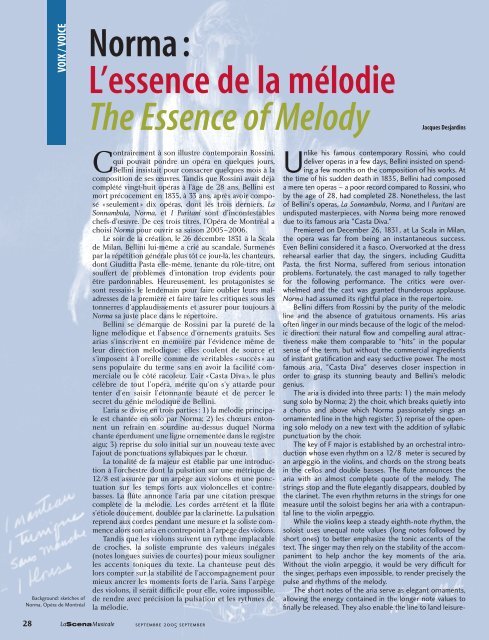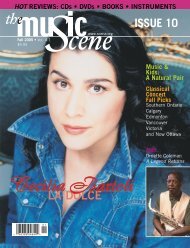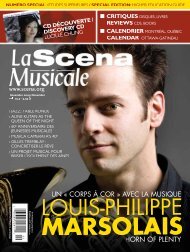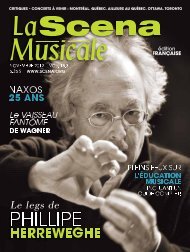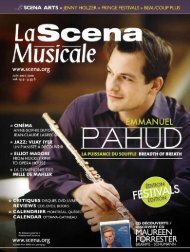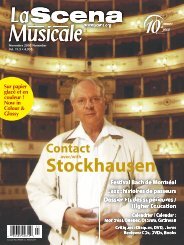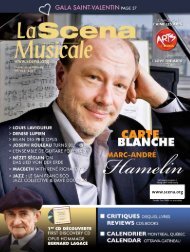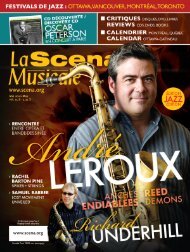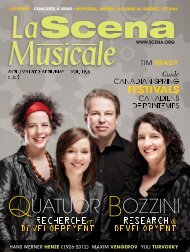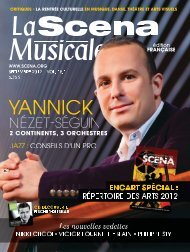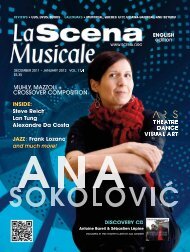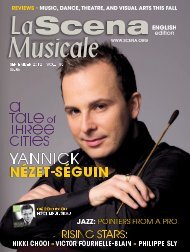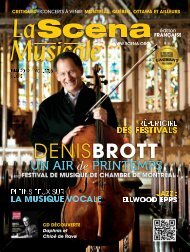You also want an ePaper? Increase the reach of your titles
YUMPU automatically turns print PDFs into web optimized ePapers that Google loves.
VOIX / VOICE<br />
Background: sketches of<br />
Norma, Opéra de Montréal<br />
Norma :<br />
L’essence de la mélodie<br />
The Essence of Melody<br />
Contrairement à son illustre contemporain Rossini,<br />
qui pouvait pondre un opéra en quelques jours,<br />
Bellini insistait pour consacrer quelques mois à la<br />
composition de ses œuvres. Tandis que Rossini avait déjà<br />
complété vingt-huit opéras à l’âge de 28 ans, Bellini est<br />
mort précocement en 1835, à 33 ans, après avoir composé<br />
« seulement » dix opéras, dont les trois derniers, <strong>La</strong><br />
Sonnambula, Norma, et I Puritani sont d’incontestables<br />
chefs-d’œuvre. De ces trois titres, l’Opéra de Montréal a<br />
choisi Norma pour ouvrir sa saison 2005–2006.<br />
Le soir de la création, le 26 décembre 1831 à la Scala<br />
de Milan, Bellini lui-même a crié au scandale. Surmenés<br />
par la répétition générale plus tôt ce jour-là, les chanteurs,<br />
dont Giuditta Pasta elle-même, tenante du rôle-titre, ont<br />
souffert de problèmes d’intonation trop évidents pour<br />
être pardonnables. Heureusement, les protagonistes se<br />
sont ressaisis le lendemain pour faire oublier leurs maladresses<br />
de la première et faire taire les critiques sous les<br />
tonnerres d’applaudissements et assurer pour toujours à<br />
Norma sa juste place dans le répertoire.<br />
Bellini se démarque de Rossini par la pureté de la<br />
ligne mélodique et l’absence d’ornements gratuits. Ses<br />
arias s’inscrivent en mémoire par l’évidence même de<br />
leur direction mélodique : elles coulent de source et<br />
s’imposent à l’oreille comme de véritables « succès » au<br />
sens populaire du terme sans en avoir la facilité commerciale<br />
ou le côté racoleur. L’air « Casta Diva », le plus<br />
célèbre de tout l’opéra, mérite qu’on s’y attarde pour<br />
tenter d’en saisir l’étonnante beauté et de percer le<br />
secret du génie mélodique de Bellini.<br />
L’aria se divise en trois parties: 1) la mélodie principale<br />
est chantée en solo par Norma; 2) les chœurs entonnent<br />
un refrain en sourdine au-dessus duquel Norma<br />
chante éperdument une ligne ornementée dans le registre<br />
aigu; 3) reprise du solo initial sur un nouveau texte avec<br />
l’ajout de ponctuations syllabiques par le chœur.<br />
<strong>La</strong> tonalité de fa majeur est établie par une introduction<br />
à l’orchestre dont la pulsation sur une métrique de<br />
12/8 est assurée par un arpège aux violons et une ponctuation<br />
sur les temps forts aux violoncelles et contrebasses.<br />
<strong>La</strong> flûte annonce l’aria par une citation presque<br />
complète de la mélodie. Les cordes arrêtent et la flûte<br />
s’étiole doucement, doublée par la clarinette. <strong>La</strong> pulsation<br />
reprend aux cordes pendant une mesure et la soliste commence<br />
alors son aria en contrepoint à l’arpège des violons.<br />
Tandis que les violons suivent un rythme implacable<br />
de croches, la soliste emprunte des valeurs inégales<br />
(notes longues suivies de courtes) pour mieux souligner<br />
les accents toniques du texte. <strong>La</strong> chanteuse peut dès<br />
lors compter sur la stabilité de l’accompagnement pour<br />
mieux ancrer les moments forts de l’aria. Sans l’arpège<br />
des violons, il serait di√cile pour elle, voire impossible,<br />
de rendre avec précision la pulsation et les rythmes de<br />
la mélodie.<br />
28 septembre 2005 september<br />
Jacques Desjardins<br />
Unlike his famous contemporary Rossini, who could<br />
deliver operas in a few days, Bellini insisted on spending<br />
a few months on the composition of his works. At<br />
the time of his sudden death in 1835, Bellini had composed<br />
a mere ten operas – a poor record compared to Rossini, who<br />
by the age of 28, had completed 28. Nonetheless, the last<br />
of Bellini's operas, <strong>La</strong> Sonnambula, Norma, and I Puritani are<br />
undisputed masterpieces, with Norma being more renowed<br />
due to its famous aria "Casta Diva."<br />
Premiered on December 26, 1831, at <strong>La</strong> Scala in Milan,<br />
the opera was far from being an instantaneous success.<br />
Even Bellini considered it a fiasco. Overworked at the dress<br />
rehearsal earlier that day, the singers, including Giuditta<br />
Pasta, the first Norma, suffered from serious intonation<br />
problems. Fortunately, the cast managed to rally together<br />
for the following performance. The critics were overwhelmed<br />
and the cast was granted thunderous applause.<br />
Norma had assumed its rightful place in the repertoire.<br />
Bellini differs from Rossini by the purity of the melodic<br />
line and the absence of gratuitous ornaments. His arias<br />
often linger in our minds because of the logic of the melodic<br />
direction: their natural flow and compelling aural attractiveness<br />
make them comparable to “hits” in the popular<br />
sense of the term, but without the commercial ingredients<br />
of instant gratification and easy seductive power. The most<br />
famous aria, "Casta Diva" deserves closer inspection in<br />
order to grasp its stunning beauty and Bellini’s melodic<br />
genius.<br />
The aria is divided into three parts: 1) the main melody<br />
sung solo by Norma; 2) the choir, which breaks quietly into<br />
a chorus and above which Norma passionately sings an<br />
ornamented line in the high register; 3) reprise of the opening<br />
solo melody on a new text with the addition of syllabic<br />
punctuation by the choir.<br />
The key of F major is established by an orchestral introduction<br />
whose even rhythm on a 12/8 meter is secured by<br />
an arpeggio in the violins, and chords on the strong beats<br />
in the cellos and double basses. The flute announces the<br />
aria with an almost complete quote of the melody. The<br />
strings stop and the flute elegantly disappears, doubled by<br />
the clarinet. The even rhythm returns in the strings for one<br />
measure until the soloist begins her aria with a contrapuntal<br />
line to the violin arpeggio.<br />
While the violins keep a steady eighth-note rhythm, the<br />
soloist uses unequal note values (long notes followed by<br />
short ones) to better emphasize the tonic accents of the<br />
text. The singer may then rely on the stability of the accompaniment<br />
to help anchor the key moments of the aria.<br />
Without the violin arpeggio, it would be very difficult for<br />
the singer, perhaps even impossible, to render precisely the<br />
pulse and rhythms of the melody.<br />
The short notes of the aria serve as elegant ornaments,<br />
allowing the energy contained in the longer note values to<br />
finally be released. They also enable the line to land leisure-


